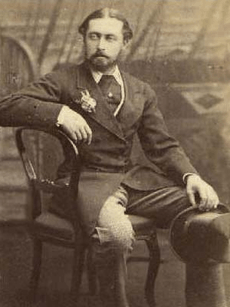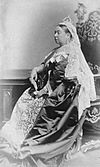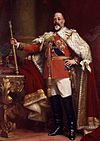History of monarchy in Australia facts for kids
Australia is a country that has a constitutional monarchy. This means that the King or Queen of the United Kingdom is also Australia's King or Queen. These countries, like New Zealand and Canada, are independent nations. They are known as Commonwealth realms, sharing the same monarch. Australia's relationship with its monarch and the British government has changed over time.
In 1770, Captain James Cook claimed the east coast of Australia for King George III of Great Britain. Eighteen years later, the colony of New South Wales was founded. Five more colonies followed: Tasmania (1825), Western Australia (1829), South Australia (1836), Victoria (1851), and Queensland (1859).
Contents
Early Royal Visits to Australia

Prince Alfred was the fourth child of Queen Victoria. He was the first member of the Royal Family to visit Australia's growing colonies. He came for five months in 1867. He was commanding his ship, Galatea. Prince Alfred visited Adelaide, Melbourne, Brisbane, Tasmania, and Sydney.
During his second visit to Sydney, an attack happened. A man named Henry James O'Farrell shot Prince Alfred. The bullet hit his spine. This attack made people in the colony very upset. They felt embarrassed. Many people protested this "outrage." Australians worried about the negative attention on their colonies.
After Prince Alfred recovered, the New South Wales Legislative Assembly decided to build a monument. It was to show thanks for his recovery. This became the Prince Alfred Hospital. The Prince allowed the hospital to use his family's coat of arms. King Edward VII later gave the hospital its "royal" title in 1902.
Fourteen years later, Prince Alfred's nephews, Princes George and Albert, visited Australia. They toured South Australia, Victoria, and New South Wales. They were midshipmen on HMS Bacchante.
Australia Becomes a Nation
On 1 January 1901, Australia became a nation. It was a self-governing part of the British monarchy.
In the late 1800s, people worried about taxes between colonies. They also worried about defence and immigration. Colonial leaders met in Melbourne in 1889. Sir Henry Parkes, known as the "Father of Federation," led the meeting. They agreed that the Australian colonies should unite under the British Crown.
A new constitution was written. Australians then presented it to London. On 1 January 1901, the six Australian colonies united. This was called the Federation. It happened after Queen Victoria approved the Commonwealth of Australia Constitution Act on 9 July 1900. Australia was first called a Dominion. From the 1950s, it was called a Commonwealth realm. This showed that Australia was equal to other countries under the shared Crown. This change officially happened with the Statute of Westminster 1931 in 1931.
The death of the Queen – cast on the Empire a shadow like the blackness of an eclipse, and nowhere was that shadow darker than in Australasia – she was the symbol – the human embodiment – of the Empire...
In 1901, Prince George (who later became King George V) returned to Australia. He opened the first Parliament of the Commonwealth of Australia in Melbourne.
In 1920, Prince Edward, Prince of Wales (later Edward VIII), visited Australia. People called him the "Digger prince." A "digger" is an Australian soldier known for bravery.
In 1927, Prince Albert (later George VI) visited Australia. He opened the first Parliament in Parliament House, Canberra, Australia's capital.
Prince Henry, Duke of Gloucester, helped celebrate Victoria's 100th birthday in 1932. In 1945, he became Governor-General of Australia. He was the only member of the Royal Family to serve as the monarch's representative in Australia.
Changes in Leadership Appointments
An important change happened when Sir Isaac Isaacs was appointed Governor-General. He was the first Australian-born Governor-General. Australia's government, led by Prime Minister James Scullin, chose him in 1930. Isaacs was a top judge in Australia.
Earlier, Prime Minister Billy Hughes had said that Australia should be asked about who becomes Governor-General. But the choice was still recommended to the King by British officials.
When Australia directly nominated Isaacs, it caused a debate. The King, George V, felt he should choose the Governor-General. He believed the Governor-General was his personal representative. However, at the 1930 Imperial Conference, it was decided that the King should follow the advice of his Australian ministers. Prime Minister Scullin had to go to London to convince the King to appoint Isaacs. The King agreed, but not easily.
This event showed that the Governor-General was Australia's constitutional representative. They were not the King's personal representative. This was a big step towards Australia's independence.
Western Australia's Secession Vote
The isolated colony of Western Australia was not keen to join the Federation. In 1933, people in Western Australia voted in a referendum. They were asked if they wanted to leave the Commonwealth of Australia. Two-thirds of the people voted yes.
The new government in Western Australia sent a group to London in 1934. They asked King George V and the British Parliament to cancel the Commonwealth of Australia Constitution Act 1900.
King Edward VIII Steps Down
On 10 December 1936, Edward VIII gave up his throne. This happened because British and Australian governments would not accept his plan to marry Wallis Simpson. She was an American woman who had been divorced. The Statute of Westminster 1931 said that Australia and other Dominions had to be asked about who would be the next King or Queen.
London offered three choices to Australia, New Zealand, South Africa, India, and Canada:
- The King marries Simpson, and she becomes Queen.
- A special marriage where Simpson would not be Queen, and any children would not inherit the throne.
- The King gives up his throne.
Australia, South Africa, and Canada chose for the King to step down. This event showed how independent Australia and other Dominions had become.
Queen Elizabeth II's Reign
In 1954, Queen Elizabeth II became the first reigning Australian monarch to visit Australia. Her visit brought a sense of stability to the nation. It also brought world attention to Australia. About 7 million Australians, nearly the whole population, came to see her.
She visited Australia many times after that, a total of 15 official visits. She was present for important events like:
- The bicentenary in 1970 of James Cook's voyage along the East Coast.
- The opening of the Sydney Opera House in 1973.
- Her Silver Jubilee in 1977.
- The announcement of the Australia Act 1986 in 1986.
- Events celebrating 200 years since the First Fleet arrived in 1988.
- The opening of the new Parliament House in Canberra in 1988.
- The 100th birthday of Federation in 2000.
- Her Golden Jubilee in 2002.
The National Carillon in Canberra was opened by Elizabeth II in 1970. The Swan Bells in Perth include bells from St Martin-in-the-Fields in London. These bells were made between 1725 and 1770. They are known to have rung when explorer James Cook sailed on his voyage that led to Australia's founding. They are the only royal bells to have left England.
Queen of Australia Title
Elizabeth II was the first monarch to be called the Queen of Australia. In 1953, the Australian Parliament passed a law. It added "Australia" to the Queen's titles. In 1973, another law removed "Defender of the Faith" from her Australian title. In 1958, Elizabeth changed the rules for the Governor-General's job.
Before this, Australian documents were signed by the monarch and a British minister. Now, they would be signed by the Prime Minister of Australia. They would also have the Royal Great Seal of the Commonwealth of Australia. Queen Victoria had ordered a Great Seal for Australia in 1900, but it was never made. In 1955, Elizabeth approved the Seal.
Another law in 1953 gave the Queen powers that the Constitution did not originally give her. The Queen could now lead Federal Executive Councils in person. She could also open the Commonwealth Parliament. Elizabeth II has done both of these things three times each.
In 1973, the power to appoint Australian ambassadors was given to the Governor-General. The Governor-General also gained the power to appoint high commissioners to Commonwealth countries. The main way the Queen and the Governor-General communicated became the Australian High Commission in London.
The 1975 Constitutional Crisis
The Australian monarch rarely gets involved in Australian politics. During the 1975 Australian constitutional crisis, the Queen remained neutral. This crisis was about the government not being able to get enough money to operate. When Governor-General Sir John Kerr dismissed Prime Minister Gough Whitlam, the Speaker of the House of Representatives asked the Queen to reverse the Governor-General's decision.
The Queen's Private Secretary replied that the Australian Constitution gives the Governor-General the power to act as the Queen's representative. The Queen would not get involved in decisions that the Constitution clearly gives to the Governor-General. She was watching events closely but would not intervene.
This showed that the Queen of Australia would not get involved in major political crises. However, there were other times when the monarch's representatives were involved in state politics. The Australia Act 1986 later clarified these relationships. It stated that state governors are appointed by the Queen only on the advice of the state Premier. British ministers have no power to advise the Queen on Australian state matters.
Future of the Monarchy
In the 1970s, more Australians started thinking about Australia's government. The 1975 crisis made many people question the monarchy's role. There were no serious attempts to change the Queen's role until the 1986 Australia Act. Australians became more aware of being an independent nation. References to the monarchy were slowly removed from public places. For example, the Queen's portrait was removed from some public buildings. The Royal Mail became Australia Post.
Public opinion began to change. Becoming a republic was not seriously discussed until 1991. That's when Prime Minister Paul Keating formed a committee to study the idea. Later, under Prime Minister John Howard, Australia held a referendum in 1999.
The first question asked if Australia should become a republic with a president chosen by parliament. The second question asked if the Constitution should include a new introduction. Neither change passed. The republic idea was defeated by 54.4% of the vote.
Four months after the referendum, the Queen visited Australia in 2000. She said that the future of the monarchy in Australia was for Australians alone to decide. She respected the referendum's outcome. She promised to continue serving as Queen of Australia to the best of her ability.
In 2006, there was a discussion about playing "God Save the Queen" at the 2006 Commonwealth Games in Melbourne. The song is Australia's official Royal Anthem. Organizers initially did not want to play it. After calls from Prime Minister John Howard, they agreed to play a short part of it. At the opening ceremony, the crowd sang "Happy Birthday" to the Queen, which then turned into a short version of "God Save the Queen."
When Prime Minister Kevin Rudd took office in 2007, he said becoming a republic was not his first priority. But he believed the debate should continue.
Australian Monarchs Since 1900
The monarchs of Australia are the same as those of the United Kingdom. Until 1942, they reigned over Australia as monarchs of the United Kingdom. From 1942, they reigned as monarchs specifically for Australia. Queen Elizabeth II was the first to be called "Queen of Australia" in 1953.
| Sovereigns of Australia from 1900 to present: | ||||||||
|---|---|---|---|---|---|---|---|---|
| # | Name | Picture | Reign | |||||
| House of Hanover | ||||||||
| 1 | Victoria |  |
1 January 1901 – 22 January 1901 | |||||
| House of Saxe-Coburg and Gotha | ||||||||
| 2 | Edward VII |  |
22 January 1901 – 6 May 1910 | |||||
| House of Windsor | ||||||||
| 3 | George V |  |
6 May 1910 – 20 January 1936 | |||||
| 4 | Edward VIII |  |
20 January 1936 – 11 December 1936 | |||||
| 5 | George VI |  |
11 December 1936 – 6 February 1952 | |||||
| 6 | Elizabeth II |  |
6 February 1952 – Present | |||||
Images for kids
-
George V with his prime ministers at the 1926 Imperial Conference. This meeting led to changes in how governors-general worked.
-
The Queen of Australia in Brisbane, 1982.







